COMMENTS ON THE ART MARKET
Sale
You may remember that in 2019 we created our first-ever sale celebrating Howard's big Six-Oh. Well, today he turned Six-Four, and this year became a grandpa. So, in celebration of these two events, of course, one is much more important than the other; we have created another sale that we are calling – The Grandpa Sale!
From now until the clock strikes midnight on July 15 (Lance’s birthday), you can purchase works from our large selection of items at a significant discount. Remember, at 12:01 on July 16, all the paintings still available return to their regular gallery pricing, so don't miss this fantastic opportunity!
Please use the link below to see all the paintings offered – included are works by many of our extremely talented contemporary artists, and there is even a selection of historical works of art.
____________________
New Artists
During the month of June, we added Leo M-H and Shana Levenson to our select roster of artists.
Leo Mancini-Hresko studied at The Florence Academy of Art and later became an instructor there. He now works and teaches from his studio in Massachusetts, employing a loose, impressionistic technique to create his compositions. The way Leo sees it, “a painting should be painted; you must see the process, the brushstrokes, creation of the ground, glazes and impastos. No two inches of any picture should be treated the same. What always drew me to painting was the contrast between rough and smooth, harsh and subtle. That is where beauty is. I hope to draw the viewer in, to see a moment in the way I do.”
Shana Levenson is a representational painter from New Mexico; she received her Bachelor’s in Fashion Design from The University of Texas, in Austin, and later, her MFA in Fine Art Painting from the Academy of Art University, in San Francisco. Shana focuses on still life and figurative work; regardless of which, she prides herself on the exquisite detail she achieves. Some of her most recent compositions feature meticulously rendered mylar balloons before stark backgrounds or floral arrangements. These paintings are unique and intriguing; the fine detail and texture allow her to capture the depth and metallic quality of her subjects.
Works by both artists will be featured in our upcoming summer shows.
____________________
Upcoming Shows
The Hamptons
The Hamptons Fine Art Fair opens its doors on the evening of July 13, and runs through July 16. Rehs Contemporary Galleries will be exhibiting a wide selection of works by many of our artists. If you are interested in attending, we still have complimentary tickets. All you need to do is send us an email and include the number of tickets you would like. All the show information is below:
Hours
Vernissage: Thursday, July 13: 6-9:30pm
Friday, July 14: 12pm – 9pm
Saturday, July 15: 12pm – 6pm
Sunday, July 16: 12pm – 6pm
Location
Southampton Fairgrounds
605 County Rd 39
Southampton, NY
Newport
This year, the Newport show has returned to the St. George's School Ice Rink, and we will have two booths. One will feature a select group of historical paintings, while the other will present a wide range of contemporary works. What makes this year's show more unique is that on opening night, Stuart Dunkel will be in our booth, creating an amazing work of art. If you are a fan of Stuart's work and will be in the area, I am sure you will enjoy watching this talented artist at work. We will have a small allotment of complimentary general admission tickets. If you would like to attend, please let us know. Show details are as follows:
Hours
Preview Party: Friday, July 28: 6pm – 9pm
Saturday: July 29: 10am – 5pm
Sunday: July 30: 10am – 5pm
Location
St. George's School Ice Rink
375 Purgatory Road
Middletown, RI
Nantucket
And please don’t forget that the weekend following the Newport show, we will be in Nantucket for The Nantucket Show. We will let you know when we receive our complimentary general admission tickets. Show details are as follows:
Hours
Preview Party: Thursday, August 3:
Friday: August 4: 10am – 6pm
Saturday: August 5: 10am – 6pm
Sunday: August 6: 10am – 5pm
Monday: August 7: 10am – 3pm
Location
Nantucket Boys and Girls Club
61 Sparks Avenue
Nantucket, RI
____________________
Stocks & Crypto
By: Lance
Hope everyone is having a nice start to their summer.
Somehow, we’re already half way through 2023, and somehow we are seeing big gains in the market all while we talk about recession fears… somebody, make it make sense! While the Dow saw a mere 3.8% gain in the last 6 months, the S&P 500 jumped 15.9% and the Nasdaq is up a staggering 31.7% in the same period. That final figure is the best first-half performance for the Nasdaq in 40 years… it was mostly fueled by tech giants like Apple, Microsoft, and Amazon, but it’s also worth noting that companies like Nvidia, Meta (Facebook/Instagram), and Tesla all saw their stock prices more than double so far in 2023.
Turning to commodities, gold and oil futures have seen mixed results this year. Gold started off on a strong run, at one point up more than 13%, but has faced downward pressure over the last couple of months… still, it is up more than 6% in 2023. It’s been a volatile year for crude; the whipsaw action has seen oil futures waver between the green and the red… at the moment, it’s down about 10% on the year.
In the cryptocurrency market, there were sizable gains across the board. Despite some volatility, cryptocurrencies continue to attract attention from investors and have gained wider acceptance as a legitimate asset class. Bitcoin, in particular, had a strong start to the year – it’s up more than 80% and has crossed back over the $30K threshold. Ethereum is up nearly 60%, while Litecoin is up more than 50%... and while those numbers are eye-popping, anyone who hasn’t been living under a rock knows that crypto gains can disappear quickly.
All that said, we’ve seen pretty impressive numbers across various indices and asset classes, at a time when most of us were probably not expecting much. And while experts will say this is unsustainable, trying to predict the future is impossible, so I’ll just keep hoping for the best and enjoy this warm weather. Have a happy and safe 4th!
____________________
Featured Artist Exhibits
This month we have dedicated Gallery 3 and Gallery 4 to:
Hammond Tony South & Nigel Cox

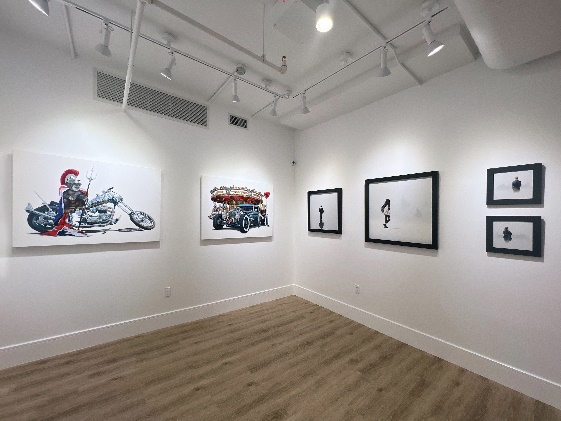
____________________
Really!
By: Amy
A Dazzling Diamond
 Get ready for some dazzling diamond news! The highly anticipated Eternal Pink debuted at Sotheby’s New York and sold for an impressive $34.8 million w/p, just a bit below its estimated value of $35 million (or $3.31M per carat). This 10.57-carat gem was discovered in Botswana by De Beers and is officially classified as a “purplish pink” diamond, which is extremely rare.
Get ready for some dazzling diamond news! The highly anticipated Eternal Pink debuted at Sotheby’s New York and sold for an impressive $34.8 million w/p, just a bit below its estimated value of $35 million (or $3.31M per carat). This 10.57-carat gem was discovered in Botswana by De Beers and is officially classified as a “purplish pink” diamond, which is extremely rare.
When determining a diamond’s value, experts consider the “four Cs”: carat, cut, color, and clarity. The Eternal Pink excels in clarity, with no visible imperfections, basically flawless, and its color is rated as “fancy vivid,” the highest grade for intense pink diamonds achieved by only 4% of them.
Though very impressive, the Eternal Pink is by no means the largest pink diamond in the world. That superlative belongs to the Darya-i-Noor, a gem that was once part of the Iranian Crown Jewels. It is over seventeen times larger than the Eternal Pink, weighing 182 carats, and is now kept at the Central Bank of Iran in Tehran. Furthermore, the Eternal Pink got nowhere near the auction record for a pink diamond. The current record stands at $71.2 million for a 59.6-carat gem sold in Hong Kong (but that only works out to $1.19M per carat). Another notable gem, the 11.15-carat Williamson Pink Star, holds the record for the highest value per carat after fetching $58 million (or $5.2M per carat).
But it is not the Eternal Pink’s size that makes it so valuable, but rather its rarity. Pink diamonds are incredibly rare and have become even rarer in recent years. It’s important to note that in 2020 Australia’s Argyle Mine closed; it was a significant source of pink diamonds. The closing has contributed to the increased prices of these precious stones. The scarcity has not only increased the price for these stones but also demand.
If any of you decide you NEED a pink diamond, reach out to us – we know a guy – RehsCo Diamonds specializes in colored diamonds
____________________
The Dark Side
By: Nathan
Michigan Gallerist Stole $1.6M From Clients
 Have you ever been caught in a lie? Have you ever tried to get out of trouble by lying again to make the initial lie make sense? Perpetually evading responsibility can be exhausting and, in the case of one Michigan gallery owner, can lead to legal trouble. Wendy Beard, the operator of the Halstead Gallery in the Detroit suburb of Birmingham, recently reached a deal with prosecutors after she got caught up in a web of her own untruths.
Have you ever been caught in a lie? Have you ever tried to get out of trouble by lying again to make the initial lie make sense? Perpetually evading responsibility can be exhausting and, in the case of one Michigan gallery owner, can lead to legal trouble. Wendy Beard, the operator of the Halstead Gallery in the Detroit suburb of Birmingham, recently reached a deal with prosecutors after she got caught up in a web of her own untruths.
Wendy Beard had been under investigation by the FBI for several years when she was arrested in October 2022. According to prosecutors, Beard made it a habit of defrauding her own clients. The straw that broke the camel’s back was when she chose to scam photojournalist J. Ross Baughman. Baughman initially made a name for himself in 1977. At the age of 23, he became the youngest recipient of a journalism Pulitzer Prize for his photographs documenting the treatment of prisoners in the white minority-ruled apartheid state of Rhodesia (now Zimbabwe). He was looking to sell part of his collection of photographs and prints through the Halstead Gallery, as that had been where he bought the first piece in his collection, a work by Diane Arbus. The gallery’s founder Thomas Halstead, who had sold him the Arbus, had since passed away, and the gallery was now in the hands of his daughter Wendy. Baughman consigned twenty pieces to the gallery, valued at around $40K, with the contract only lasting a year. After three years, Baughman had not received any money, nor had he received his collection back.
This was Beard’s way of conning people of their money and their art. She habitually received works on consignment but failed to notify the owners when the pieces sold. She also would receive payment for works and then conveniently forget to have them delivered before ghosting her clients entirely. Of course, this is no way to run a business, as people are bound to complain. To counter this, Beard decided to make up lie after lie to excuse all of the missing money and art that had seemingly disappeared. According to court documents, she created email addresses for employees she had entirely made up. She fabricated medical emergencies as excuses, including a double lung transplant on one occasion and a “months long coma” on another. Works consigned to the gallery that went unsold were not returned to their owners but went up on the walls of her home. Her most audacious stunt was when a client asked that she return their unsold Ansel Adams photograph Tenaya Creek, Dogwood, Rain. However, when they got the photo back, the owner noticed Adams’s signature was now missing. By looking through PayPal records, the FBI discovered that Beard bought a $375 print from the Ansel Adams Gallery website and chose to pass it off as the signed original. It is unknown whether she kept the original photograph or sold it without notifying the owner. Ansel Adams photographs were commonly consigned to the gallery, including the most valuable work in this affair. One of Beard’s clients had consigned the photo The Tetons and the Snake River, Grand Teton National Park, along with several other works, with Beard valuing the collection at $900K. Beard later sold The Tetons and the Snake River to a gallery in Wyoming for $440K, pocketing every penny instead of charging her expected 5% commission. The photograph currently belongs to a collector in Idaho, who purchased it for $685K.
The FBI criminal complaint names five victims, but there are doubtless many more. One anonymous client only learned about Beard’s shady dealings when news reporters broke the story on television. The FBI estimates Beard stole around one hundred photographs and prints as well as about $1.6 million from her clients. Beard is now being charged with wire fraud, and facing a prison sentence of up to twenty years. If she pleads guilty, she must pay back the money she stole from her clients. But it is unknown if any of Beard’s victims will have their art returned to them.
Nazi-Looted Painting Returned From Japan
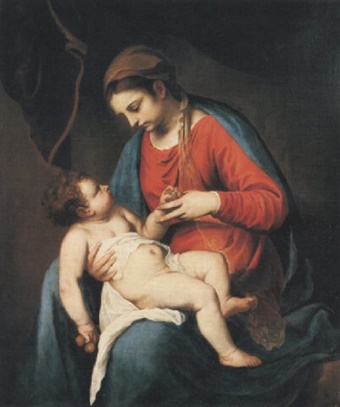
Despite being far off from European battlefields, there is more Nazi loot in Japan than you might expect. Last year, I wrote about how the descendants of a Jewish family whose art collection was looted by the Nazis during the Second World War are in the process of suing a Japanese company. The company’s museum contains a Van Gogh sunflower painting that was illegally confiscated during the war and later purchased by the company’s owner. And now, just last week, Japanese authorities are repatriating an Italian Baroque masterpiece to Poland nearly eighty years after the Nazis looted it from the country.
Alessandro Turchi was a northern Italian Baroque painter who mainly lived and worked in and around Verona. He was a contemporary of Caravaggio, and Turchi was influenced by him, as seen by the chiaroscuro in some of his biblical and historical scenes. Turchi executed his painting Madonna with Child sometime in the early to mid-sixteenth century and, until 1940, it hung in the Lubomirski Palace in Przeworsk, a small town in the southeast of Poland about 113 miles east of Kraków. The Germans confiscated the painting during their occupation of the country in the 1940s, and it was not seen again for decades. Kajetan Mühlmann, an Austrian art historian and SS officer, considered it one of Poland’s 500 most valuable artworks, along with works by Rembrandt, Leonardo, and Raphael.
Polish authorities spotted the painting on the website of Mainchi Auction in January 2022 and had it pulled from the sale before the bidding began. In a rare act of generosity and understanding, the painting’s owner, who consigned it to Mainchi Auction in Tokyo, agreed to the repatriation without compensation. Japan officially returned the work to Poland in a ceremony at Tokyo’s Polish embassy last Thursday. Poland’s current efforts to return looted works to the country have resulted in the repatriation of around 600 works of art. Turchi’s Madonna with Child is the first to be returned from Japan. The works returned to Poland so far only make up a fraction of the estimated 66,000 works of art taken during the war. The country’s deputy prime minister Piotr Gliński says the painting will likely be sent to a regional museum near Przeworsk first before permanently hanging at the Lubomirski Princes Museum in Wrocław after renovations are complete.
Garbage In, Garbage Out: Miami Beach Sues Artist Over Shoddy Work
 As much as many of us may want to, punishing an artist over bad art can be very difficult. But Sarah Morris is now discovering that it is possible to do just that. The city of Miami Beach, Florida, is suing Morris because they allege poor artistry pertaining to her site-specific art at the Miami Beach Convention Center. In October 2016, the city of Miami Beach commissioned Morris to create a design that would adorn parts of the northern and eastern walls of the convention center as part of its renovation. The city also hired Franz Ackermann to decorate other parts of the exterior walls, Ellen Harvey to decorate some of the interior walls, as well as Joep van Lieshout, Michael Elmgreen, and Ingar Dragset to create sculptures. The final work consisted of a colorful pattern made from ceramic tiles. Morris titled the work Morris Lapidus, named after one of the leaders of 1950s Miami Modern architecture best known for designing the Fontainebleau Hotel. According to Morris’s contract with the city, the artist would be responsible for creating and installing the tiles and inspecting the walls to ensure they are suitable for the project. The city further specified that Morris would be accountable for repairing any damages to the work for the first two years after the completion of the work. The project ran three months behind schedule, but installation ended in July 2019. Morris received $1.1 million for the job. (Photo courtesy of Miami Dade Country Courts)
As much as many of us may want to, punishing an artist over bad art can be very difficult. But Sarah Morris is now discovering that it is possible to do just that. The city of Miami Beach, Florida, is suing Morris because they allege poor artistry pertaining to her site-specific art at the Miami Beach Convention Center. In October 2016, the city of Miami Beach commissioned Morris to create a design that would adorn parts of the northern and eastern walls of the convention center as part of its renovation. The city also hired Franz Ackermann to decorate other parts of the exterior walls, Ellen Harvey to decorate some of the interior walls, as well as Joep van Lieshout, Michael Elmgreen, and Ingar Dragset to create sculptures. The final work consisted of a colorful pattern made from ceramic tiles. Morris titled the work Morris Lapidus, named after one of the leaders of 1950s Miami Modern architecture best known for designing the Fontainebleau Hotel. According to Morris’s contract with the city, the artist would be responsible for creating and installing the tiles and inspecting the walls to ensure they are suitable for the project. The city further specified that Morris would be accountable for repairing any damages to the work for the first two years after the completion of the work. The project ran three months behind schedule, but installation ended in July 2019. Morris received $1.1 million for the job. (Photo courtesy of Miami Dade Country Courts)
Not even a year later, starting in the spring of 2020, tiles began to crack and fall off the walls. In the autumn, there were some days when twenty or thirty tiles per day were detaching from the wall, leaving heaps on the ground. The city had to erect protective barriers to prevent people from getting too close to the wall lest a falling tile strike a passerby. The city first contacted Morris in April 2020, prompting her to hire two contracting companies to inspect the walls. By the end of the year, after Morris took no action, the city had to hire a third engineering firm, which told them that one of the walls was completely unsuitable for the project and that all the tiles should be removed.
Miami Beach is seeking $1 million from Morris, her company Parallax LLC, and the two contracting companies Morris hired. Morris’s lawyers have called the lawsuit “an affront to the artist and to Miami Beach’s own standing among the leading cities hosting Ms. Morris’s work.” Morris and her lawyers are also trying to deflect blame onto, of all people, the construction company that built the convention center walls. However, the city, both in the initial contract and the lawsuit, stated clearly that “if [the convention center]’s walls could not support the Artwork, it was Artist’s contractual duty to notify the City before the Artwork was installed and to design a means of mitigating this issue”. Morris now demands that the city should pay for the tiles’ removal since, as her lawyers are keen to point out, Morris is an “internationally-acclaimed artist”, and paying for the damages would be detrimental to that reputation.
A Totally Bananas Lawsuit
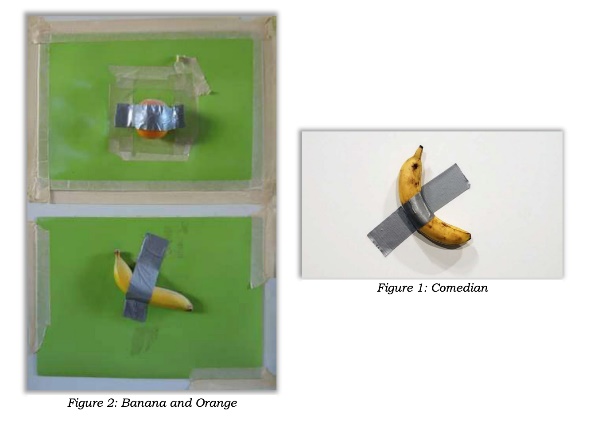 Not long ago, I wrote about Maurizio Cattelan’s absurdist conceptual work Comedian, consisting of a banana duct taped to a wall. Upon seeing a licensed version of the work displayed at the Leeum Museum in South Korea, one visitor decided to remove the tape and eat the banana while his friend recorded the incident on his phone. Comedian, in a way, is meant to be provocative, but one artist may have taken things a little too seriously. In 2020, the American artist Joe Morford sued Cattelan, alleging that Comedian was a copy of his 2002 work Banana & Orange, consisting of plastic replicas of the titular fruits duct taped to green panels. Cattelan, however, claims that he had not even heard of Morford before the lawsuit and had independently thought of Comedian as a concept as early as 2018. Cattelan’s studio assistant verified this claim in court.
Not long ago, I wrote about Maurizio Cattelan’s absurdist conceptual work Comedian, consisting of a banana duct taped to a wall. Upon seeing a licensed version of the work displayed at the Leeum Museum in South Korea, one visitor decided to remove the tape and eat the banana while his friend recorded the incident on his phone. Comedian, in a way, is meant to be provocative, but one artist may have taken things a little too seriously. In 2020, the American artist Joe Morford sued Cattelan, alleging that Comedian was a copy of his 2002 work Banana & Orange, consisting of plastic replicas of the titular fruits duct taped to green panels. Cattelan, however, claims that he had not even heard of Morford before the lawsuit and had independently thought of Comedian as a concept as early as 2018. Cattelan’s studio assistant verified this claim in court.
According to Morford, Cattelan clearly plagiarized his work because of the availability of images of Banana & Orange online and composition similarities. Morford posted photos of Banana & Orange on several online platforms, including Facebook, Blogspot, and YouTube. Therefore, Morford claims that this proves that Cattelan could view the work and steal its concept. Furthermore, he claimed that Comedian and Banana & Orange are so similar that it is likely that Cattelan’s work was heavily influenced by or stolen from Morford.
Judge Robert Scola of the District Court for the Southern District of Florida granted summary judgment in favor of Cattelan, thereby dismissing Morford’s case. On Morford’s first argument, Scola wrote that just because images of Banana & Orange were available online, that does not indicate that Cattelan viewed these images; or that “mere availability, and therefore possibility of access, is insufficient to prove access.” Regarding the similarities between Banana & Orange and Comedian, Scola found that Comedian does not constitute plagiarism because “there are only so many ways to express the concept of a banana taped to a wall.” Morford alleged that placing the tape perpendicularly to the banana was one of the elements Cattelan copied from Banana & Orange. But according to Scola, this is the rather obvious way to execute the work. “Placing the tape parallel with the banana would cover it. Placing more than one piece of tape over the banana, at any angle, would necessarily obscure it. An artist seeking to tape a banana (or really, any oblong fruit or other household object) to a wall is therefore left with ‘only a few ways of visually presenting the idea’ — all of which involve a piece of tape crossing the banana at some non-parallel angle.” The court did, however, find that there were protected elements of Morford’s work, such as the green panels, the use of an orange, and the use of masking tape to hang the panels onto a wall. But none of these elements are present in Comedian. Morford even went as far as to say that both bananas were placed at similar angles, indicating possible plagiarism. To this, Scola responded, “There are only so many angles at which a banana can be placed on a wall (360, to be precise, unless one breaks the measurements down beyond degrees—but making such a minute distinction would be reaching a point of absurdity best left out of the courts and in the hands of artists).” So, it seems ‘close enough’ doesn’t really cut it.
The court found that Comedian is not a copy or plagiarized version of Banana & Orange, but rather the two are different expressions of the same idea. When you break down each work into its component parts, they are quite different. So, an artist cannot own and claim copyright over the idea of taping a banana to a wall. The art world can breathe a sigh of relief.
Art Thieves Nabbed After Twenty Years
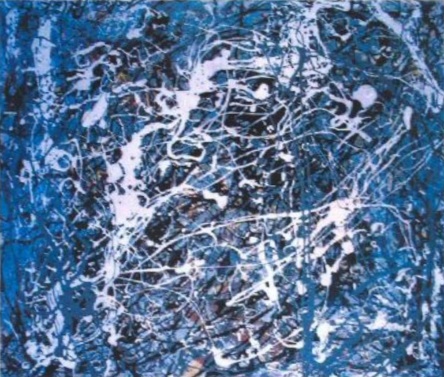 For over twenty years, a ring of thieves terrorized museums and antique shops across the United States, stealing millions of dollars worth of valuables. Gerard Karam, the attorney for the Middle District of Pennsylvania, announced last week that his office has identified the members of this organization, pressing charges against nine individuals. While these men normally resorted to stealing sports memorabilia, jewels, and antiques, most are talking about the art they stole. On November 18, 2005, the group broke into the Everhart Museum in Scranton, Pennsylvania. They took only two items: a 1984 silkscreen by Andy Warhol and a 1949 Jackson Pollock painting Springs Winter, valued at $11.6 million. At the time, police estimated the entire heist took a mere ten minutes to pull off.
For over twenty years, a ring of thieves terrorized museums and antique shops across the United States, stealing millions of dollars worth of valuables. Gerard Karam, the attorney for the Middle District of Pennsylvania, announced last week that his office has identified the members of this organization, pressing charges against nine individuals. While these men normally resorted to stealing sports memorabilia, jewels, and antiques, most are talking about the art they stole. On November 18, 2005, the group broke into the Everhart Museum in Scranton, Pennsylvania. They took only two items: a 1984 silkscreen by Andy Warhol and a 1949 Jackson Pollock painting Springs Winter, valued at $11.6 million. At the time, police estimated the entire heist took a mere ten minutes to pull off.
The ring of art thieves mainly operated in Pennsylvania, New Jersey, and New York but also performed robberies in Rhode Island, Massachusetts, Washington DC, and even as far as North Dakota. Most of what they stole was not art, though. A majority of their loot consisted of sports memorabilia and other collectibles. In 2014, the thieves executed a heist at the Yogi Berra Museum in Little Falls, New Jersey. They made off with nine of Berra’s ten World Series rings. Investigators say it’s likely that they subsequently melted them down into their raw materials and sold them. And that job in North Dakota? The group broke into the Roger Maris Museum in Fargo, stealing the Yankee’s Hickok Belt from 1961. They also stole hundreds of thousands of dollars in gold and over a million dollars in antique firearms.
Despite some of the robberies happening 20 years ago, investigators could only uncover the thieves’ identities thanks to forensic evidence discovered about three years ago. Of the nine individuals charged, eight have already turned themselves in. Five have already entered preliminary plea agreements, where they agree to plead guilty to charges of theft and conspiracy. The last suspect is Nicholas Dombek, who is now considered a fugitive. Prosecutors have filed additional charges against Dombek, namely concealment or disposal of a major artwork. After stealing a painting by the Hudson River School artist Jasper Francis Cropsey from New Jersey’s Ringwood Manor in 2011, Dombek allegedly destroyed it to prevent it from being used as evidence against him.
Much of the group’s loot has not been recovered yet, and it is unknown if the museums and private businesses will ever have their stolen items returned to them.
____________________
The Art Market
By: Amy
Frazetta Sets A Record
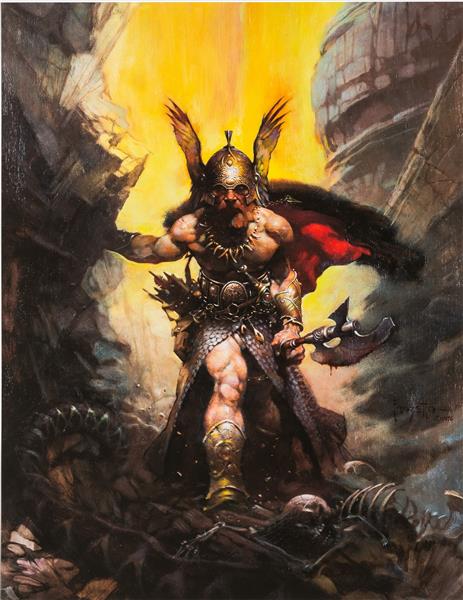 Frank Frazetta, the legendary artist known for his extraordinary talent in the realms of comic book and fantasy art, has created numerous iconic and highly sought-after paintings throughout his career. Among his most notable works is Dark Kingdom; the painting was used as the cover art for Karl Edward Wagner’s 1976 novel Dark Crusade and Molly Hatchet’s album Flirtin’ With Disaster. Yesterday, June 22nd, Dark Kingdom achieved an unrivaled status as the world’s most valuable original comic book or fantasy art.
Frank Frazetta, the legendary artist known for his extraordinary talent in the realms of comic book and fantasy art, has created numerous iconic and highly sought-after paintings throughout his career. Among his most notable works is Dark Kingdom; the painting was used as the cover art for Karl Edward Wagner’s 1976 novel Dark Crusade and Molly Hatchet’s album Flirtin’ With Disaster. Yesterday, June 22nd, Dark Kingdom achieved an unrivaled status as the world’s most valuable original comic book or fantasy art.
Dark Kingdom immerses viewers in a scene that ignites the imagination, depicting a heroic figure adorned in magnificent armor, wielding a sword that gleams with an otherworldly radiance. Frazetta’s masterful brushstrokes capture the essence of a difficult journey, transporting us to a place packed with mystical creatures, ancient ruins, and enigmatic secrets. The composition evokes a sense of urgency, as if the fate of entire kingdoms hangs in the balance, making it a visual feast for adventurous souls who dare to embark on epic quests within the pages of a novel.
Before the sale of Frazetta’s Dark Kingdom painting, his 1969 masterpiece Egyptian Queen held the record price when it sold for $5.4 million in 2019. Egyptian Queen demonstrates Frazetta’s ability to depict the allure and strength of his female subjects. The work was created for the magazine Eerie #23, and the original painting remained in the Frazetta family.
Frazetta now holds the top two spots for prices achieved at auction for original works of comic book or fantasy art—a true testament to his exceptional artistic ability, captivating narratives, and enduring appeal. Furthermore, the value of these works extends beyond their aesthetic brilliance as they take us to places where heroes rise and dreams come alive.
If you’re intrigued by Frazetta’s work, let me introduce you to two notable names – Julie Bell and Boris Vallejo. Today, Bell is considered one of the most important artists in the fantasy and wildlife fields, often portraying strong, fierce characters and breathtaking scenes filled with imaginative creatures and landscapes. Vallejo, who is now married to Bell, is renowned for his fantasy and science fiction artwork. He creates paintings featuring muscular heroes and heroines engaged in epic battles set in fantastical landscapes. Their incredible attention to detail and vibrant colors make each of their works truly fascinating.
Sotheby’s London Modern & Contemporary Sale
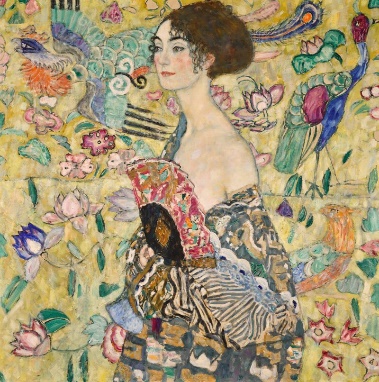 On Tuesday, June 27th, Sotheby’s London hosted its Modern and Contemporary evening sale. News outlets had reported on this particular sale months prior, mainly because of a single lot: Gustav Klimt’s portrait Lady with a Fan. The portrait is one of Klimt’s last masterworks, with it being discovered on his easel at the time of his death in 1918. It last sold at Sotheby’s New York in 1994 for $10.6M hammer, setting Klimt’s auction record. This time, the Klimt exceeded its £65M estimate, achieving £74M / $94.36M (or £85.3M / $108.78M w/p). This set Klimt’s new auction record, beating out the painting Birch Forest, which sold for $91M hammer (or $104.59M w/p) at Christie’s New York as part of the Paul Allen collection last November. The portrait also set the record for most valuable artwork sold at auction in Europe, pushing out Alberto Giacometti’s sculpture L’homme qui marche II, which sold at Sotheby’s London in 2010 for £65M w/p. Lady with a Fan eventually made up about 46% of the entire sale’s total.
On Tuesday, June 27th, Sotheby’s London hosted its Modern and Contemporary evening sale. News outlets had reported on this particular sale months prior, mainly because of a single lot: Gustav Klimt’s portrait Lady with a Fan. The portrait is one of Klimt’s last masterworks, with it being discovered on his easel at the time of his death in 1918. It last sold at Sotheby’s New York in 1994 for $10.6M hammer, setting Klimt’s auction record. This time, the Klimt exceeded its £65M estimate, achieving £74M / $94.36M (or £85.3M / $108.78M w/p). This set Klimt’s new auction record, beating out the painting Birch Forest, which sold for $91M hammer (or $104.59M w/p) at Christie’s New York as part of the Paul Allen collection last November. The portrait also set the record for most valuable artwork sold at auction in Europe, pushing out Alberto Giacometti’s sculpture L’homme qui marche II, which sold at Sotheby’s London in 2010 for £65M w/p. Lady with a Fan eventually made up about 46% of the entire sale’s total.
The other top lots were just as Sotheby’s specialists predicted. Next up after the Klimt was Lucian Freud’s painting Night Interior, showing the inside of Freud’s apartment and one of his models, Penny Cuthbertson, resting nude in a chair. This is one of seven works featuring Cuthbertson that Freud produced from 1966 to 1970. Tuesday’s sale marked Night Interior’s auction debut, valued at between £8M and £12M by Sotheby’s. It just barely snuck over the minimum, with the hammer coming down at £8.1M / $10.33M (or £9.6M / $12.2M w/p). Coming up right behind the Freud was an untitled work by Cy Twombly. It is a typical Twombly work, consisting of crayon scribbles overtop a layer of oil-based house paint on 61 by 74.75-inch canvas. Having the same estimate range as the Freud, the Twombly fell off the other side of the minimum estimate, falling short at £7.9M / $10M (or £8.9M / $11.4M w/p). The sale had few surprises, with the only one of note being the very last lot. It was an untitled work made of carbonized terracotta by the Kenyan-born British potter Dame Magdalene Odundo. Created in 1999, the piece resembles a vase with a long neck adorned with small loops and is exemplary of her larger oeuvre influenced by pottery from Europe, Africa, and the Americas. Estimated to sell for between £100K and £150K, the vase eventually sold for £420K / $535.5K (or £533.4K / $680.15K w/p), or almost three times its high estimate.
Overall, the sale brought in £160.21M / $204.3M against a total estimate range of £154.54M to £195M. Of the fifty-nine available works, twenty-five sold within estimate, giving Sotheby’s specialists an incredible 42% accuracy rate. Fifteen lots (25%) sold below estimate, while ten lots (17%) sold above, and nine lots (15%) went unsold. Among the unsold were highly-valued works by Edvard Munch and Claude Monet.
Point of Pride: The Top LGBT Artists Of All Time
It's nearing the end of Pride Month, and I would be remiss if I didn’t write something apropos celebrating those great artists who also happen to be community members. LGBT people have always been among us, and this time of year is the time to single them out, elevate them, and celebrate them. So this is my list of LGBT artists, both historical and contemporary. This is by no means a comprehensive list, nor is it a ranking. These are just some of my favorites. I might even make another since there are too many to narrow down to just five.
Frida Kahlo
 Despite the self-portrait being an incredibly personal work that most artists would probably keep to themselves, most of Frida Kahlo’s best-known works involve her own image. Whether it’s The Two Fridas, Self-Portrait with Cropped Hair, or Diego y Yo, Kahlo’s personalization of her art has made her an icon. She was also incredibly influential by blending Mexican folk art with other symbols in a surrealist fashion, often providing commentary on her own experiences and contemporary issues like gender, sexuality, and Mexico’s relationship with the United States. Her portrayal of herself through her art became a sort of reclamation, defying traditional gender roles and symbolizing female empowerment. Further, she celebrated Mexico’s indigenous heritage when the country was recovering from its bloody revolutionary wars and redefining itself through the arts. Kahlo’s husband Diego Rivera was also involved in this through his famous murals. Kahlo’s relationships were not limited to just men, though. Her turbulent marriage to Rivera remains one of the most oft-discussed aspects of her life, but her diaries and journals contain love letters to other men and women. Some speculate that she had an affair with renowned Mexican singer Chavela Vargas. Additionally, when Kahlo lived in New York for three months, she allegedly had affairs with the photographer Nickolas Muray and the great American painter Georgia O’Keeffe.
Despite the self-portrait being an incredibly personal work that most artists would probably keep to themselves, most of Frida Kahlo’s best-known works involve her own image. Whether it’s The Two Fridas, Self-Portrait with Cropped Hair, or Diego y Yo, Kahlo’s personalization of her art has made her an icon. She was also incredibly influential by blending Mexican folk art with other symbols in a surrealist fashion, often providing commentary on her own experiences and contemporary issues like gender, sexuality, and Mexico’s relationship with the United States. Her portrayal of herself through her art became a sort of reclamation, defying traditional gender roles and symbolizing female empowerment. Further, she celebrated Mexico’s indigenous heritage when the country was recovering from its bloody revolutionary wars and redefining itself through the arts. Kahlo’s husband Diego Rivera was also involved in this through his famous murals. Kahlo’s relationships were not limited to just men, though. Her turbulent marriage to Rivera remains one of the most oft-discussed aspects of her life, but her diaries and journals contain love letters to other men and women. Some speculate that she had an affair with renowned Mexican singer Chavela Vargas. Additionally, when Kahlo lived in New York for three months, she allegedly had affairs with the photographer Nickolas Muray and the great American painter Georgia O’Keeffe.
Keith Haring
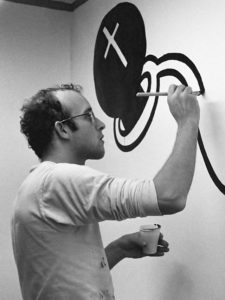
Some artists on this list are not explicitly queer artists but rather artists who happen to be queer. But Keith Haring was definitely not one of those. He interwove his gayness through his art. Influenced by street art, European abstract painting, and popular culture, Haring developed his own visual language, using symbols like the heart, barking dogs, and what became known as the “radiant baby”. In doing so, he became a central member of New York’s underground art scene in the 1980s along with Jean-Michel Basquiat and fellow Pittsburgh native Andy Warhol. Haring also emphasized accessibility. He sought to remove art's perceived elitism by bringing art into people’s everyday life. He did so by doodling on blank advertising space in the subway, receiving commissions for large-scale public murals, and opening up his Pop Shop in 1986. His art also had direct messages, including opposition to South African apartheid, nuclear disarmament, environmentalism, and drugs. As a gay artist active in the 1980s, Haring called attention to the AIDS epidemic and the Reagan administration’s embarrassing silence on the issue. His volume of work on this particular topic increased following his own HIV diagnosis in late 1988. One of his most famous works is his 1989 mural Once Upon a Time…, located in the second-floor bathroom of the Lesbian, Gay, Bisexual & Transgender Community Center on West 13th Street in Greenwich Village. It is an incredibly sexually-explicit work that serves as a reminder of hookup culture among LGBT people in a time before HIV/AIDS. It is confrontational eroticism, but it is also a cautionary tale. Even over thirty years after his death, Haring’s style and visual language persist across our culture, and his works remain popular today, influencing contemporary street and pop artists like Banksy and KAWS.
Jean-Michel Basquiat

Jean-Michel Basquiat is considered one of the greatest American artists of the late twentieth century, and especially one of the biggest stars of the underground art scene in New York. Like many of his colleagues, Basquiat sought to defy convention in his work. Born to a Haitian father and a Puerto Rican mother in Brooklyn, much of his work dealt with ideas of race and colonialism, as well as the Black and Caribbean experience in America. He even sought to defy convention through his preferred media, ranging from acrylic paints to crayons applied to anything from burlap to linen, paper, and cardboard. Though many of his friends were aware of his romantic and sexual relationships with men and women, that part of his life rarely explicitly appeared in his paintings, which means many are often surprised when they learn about Basquiat’s bisexuality. His girlfriend Suzanne Mallouk once said that Basquiat was “attracted to people for all different reasons. They could be boys, girls, thin, fat, pretty, ugly… He was attracted to intelligence more than anything and to pain.”
(Photo credit: J. Paul Getty Museum, Los Angeles )
Leonardo da Vinci
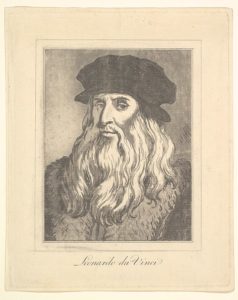
Leonardo was, without a doubt, one of the most remarkable humans who ever lived. Not only was he an artist, but he was an inventor, an engineer, a scientist, an architect, and a ninja turtle… wait, wrong one. Furthermore, as far as historical figures go, there are few people whose sexuality and personal life have been more vigorously discussed. Despite the extensive notes and journals he left behind, Leonardo rarely commented on his personal life, leading to much speculation about his sexuality. Leonardo never married, and there is little documentary evidence that he ever had romantic or sexual relationships. Some have hypothesized that he had romances with friends and pupils, including Andrea Salaì and Francesco Melzi. Others say that he was dedicated to his work to the point that personal relationships were not a priority. The only piece of documentary evidence that alludes to Leonardo’s sexuality is a legal document from 1476. At the time, Leonardo was a 24-year-old apprentice in the workshop of the sculptor Verrocchio. He was named in a denunciation that accused him and three others of engaging with a male prostitute. The charges were eventually dismissed on a technicality since the denunciation was anonymous and therefore did not meet legal standing. Some historians speculate that while Leonardo was probably queer by modern standards, this legal case eventually drove him to celibacy, explaining his lack of personal relationships.
Kehinde Wiley
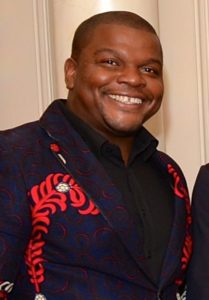 Moving out of the Renaissance into something more contemporary, Kehinde Wiley is one of the most in-demand portraitists working today. Wiley’s style is defined by his expert synthesis of the conventions of Old Master portraiture with elements of contemporary street art. For example, when I last visited the Brooklyn Museum, I was particularly struck by his 2005 painting Napoleon Leading the Army Over the Alps. The work borrows from Jacques-Louis David’s equestrian portrait of Napoleon Bonaparte, replacing the alpine background with a red and gold decorative pattern and placing a Black man in military fatigues on horseback instead of the infamous French emperor. Similarly, the Anthony van Dyck portrait Charles I at the Hunt inspired Wiley’s Le Roi au le Chasse II, which sold for $280K hammer at Sotheby’s New York. Wiley’s goal is to depict people of color in positions of power previously reserved for European royalty and great military leaders. He elevates marginalized communities by using random people on the street as his kings and emperors. Though he’s been working since 2001, Wiley shot to fame in 2018 when the National Portrait Gallery commissioned him to create a portrait of President Barack Obama. In the painting, the president is sitting in a simple wooden chair against an incredibly verdant background featuring chrysanthemums (representing Chicago), jasmines (representing Hawaii, the state of his birth), and African blue lilies (representing his father’s native Kenya). He is the first Black artist and the first LGBT artist to create an officially-commissioned presidential portrait. Wiley identifies as gay, and some have commented on how his portraits’ subjects sometimes subvert gender norms. Conceptions of gender and sexuality have changed drastically in the centuries since Anthony van Dyck and Jacques-Louis David were alive. Therefore, expressions of power and luxury expressed in the original works can seem camp or even feminine by some modern standards. Taking a person of color walking the streets today and placing them in those poses and clothing only highlights this.
Moving out of the Renaissance into something more contemporary, Kehinde Wiley is one of the most in-demand portraitists working today. Wiley’s style is defined by his expert synthesis of the conventions of Old Master portraiture with elements of contemporary street art. For example, when I last visited the Brooklyn Museum, I was particularly struck by his 2005 painting Napoleon Leading the Army Over the Alps. The work borrows from Jacques-Louis David’s equestrian portrait of Napoleon Bonaparte, replacing the alpine background with a red and gold decorative pattern and placing a Black man in military fatigues on horseback instead of the infamous French emperor. Similarly, the Anthony van Dyck portrait Charles I at the Hunt inspired Wiley’s Le Roi au le Chasse II, which sold for $280K hammer at Sotheby’s New York. Wiley’s goal is to depict people of color in positions of power previously reserved for European royalty and great military leaders. He elevates marginalized communities by using random people on the street as his kings and emperors. Though he’s been working since 2001, Wiley shot to fame in 2018 when the National Portrait Gallery commissioned him to create a portrait of President Barack Obama. In the painting, the president is sitting in a simple wooden chair against an incredibly verdant background featuring chrysanthemums (representing Chicago), jasmines (representing Hawaii, the state of his birth), and African blue lilies (representing his father’s native Kenya). He is the first Black artist and the first LGBT artist to create an officially-commissioned presidential portrait. Wiley identifies as gay, and some have commented on how his portraits’ subjects sometimes subvert gender norms. Conceptions of gender and sexuality have changed drastically in the centuries since Anthony van Dyck and Jacques-Louis David were alive. Therefore, expressions of power and luxury expressed in the original works can seem camp or even feminine by some modern standards. Taking a person of color walking the streets today and placing them in those poses and clothing only highlights this.
Some More Great LGBT Artists
This is the second half of my personal list of great LGBT artists (it was getting a little long, so I had to break it up).
Rosa Bonheur

Rosa Bonheur was a French realist painter best known for her animal paintings. Nowadays, she’s mostly known for her work portraying horses and cattle. One of her best-known works, The Horse Fair, was exhibited at the 1853 Salon and has been a highlight of the Metropolitan Museum of Art’s collection since 1887. She pioneered artistic ability in accurately and dynamically portraying wildlife through painting and sculpture. Today, scholars have extensively studied both her art and her personal life. Bonheur was an LGBT, specifically lesbian, icon. Bonheur never married and never had children. She had several relationships with women throughout her life, most importantly with her partner of forty years, Nathalie Micas, who is buried alongside Bonheur at Paris’s Père Lachaise cemetery. Micas was a painter and inventor. Though her artistic endeavors were always overshadowed by Bonheur’s, she achieved some recognition after patenting a new railway brake exhibited at the 1893 Chicago World's Fair. Micas was also the homemaker of the pair and managed their finances and business dealings. Some scholars have written that Bonheur probably would not have been as successful for as long as she was without help from her partner. Throwing a little bit of gender-bending into the mix, Bonheur was also a cross-dresser. She frequently wore men’s clothing in public, allowing her access to cattle markets and stockyards where women were often not permitted. She even got a special license from the French police that allowed her to do so. She was also known to smoke tobacco and go hunting, pastimes reserved exclusively for men according to nineteenth-century social custom. After Micas died in 1889, Bonheur later began living with American genre painter and portraitist Anna Elizabeth Klumpke. The two lived together until Bonheur’s death in 1899. Klumpke later wrote one of the first Bonheur biographies, subtitled Sa vie, son œuvre (Her Life, Her Work). It would not be inappropriate to say that Rosa Bonheur walked so that others like Frida Kahlo could run. (Photo: Rosa Bonheur on the right, Nathalie Micas on the left)
Michelangelo Buonarroti
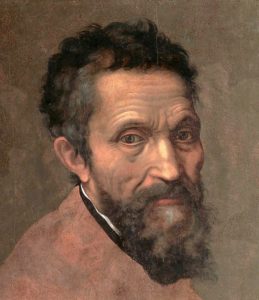
Like fellow ninja turtle Leonardo, Michelangelo Buonarroti was an incomparable creative mind. Though he was primarily a sculptor, Michelangelo is equally well known for his painting, including the ceiling and walls of the Sistine Chapel. He was also an architect, with his plans chosen as the final design for St. Peter’s Basilica when it was rebuilt starting in 1506. Following earlier sculptors like Donatello, Michelangelo revolutionized sculpture and helped revive artistic conventions neglected during the medieval period. Like many artists, Michelangelo never married or had any children, throwing himself into his work instead. Scholars speculate that Michelangelo was probably neurodivergent. He was incredibly reclusive and did not particularly enjoy social interaction. Michelangelo also had incredible attention to detail, possibly bordering on hyperfixation. He would work for days on end on a particular work without resting, changing his clothes, or removing his boots. Concerning his boots, his biographer Ascanio Condivi wrote that he would wear them continuously to the point that "subsequently along with his boots, he sloughed off his skin, like a snake’s." Scholars have also speculated that Michelangelo was probably gay or bisexual. Like Leonardo, some of his contemporaries commented that Michelangelo was celibate for much of his life, with Condivi describing him as “monk-like”. Probably the greatest source of documentary evidence that leads many to believe Michelangelo was LGBT is his poetry. On top of being a renowned sculptor, painter, and architect, Michelangelo wrote hundreds of poems, specifically sonnets and madrigals. Among them are thirty love poems dedicated to his friend Tommaso de’ Cavalieri. In one sonnet, he included a pun on Cavalieri’s name, writing, “If only chains and bands can make me blest, / No marvel if alone and bare I go / An arméd Knight’s captive and slave confessed” (cavalier being the word used by Michelangelo for Knight, or cavaliere in modern Italian). Michelangelo’s poetry was first published nearly sixty years after his death, with the first volume edited and published in 1623 by his grandnephew, also named Michelangelo. However, the younger Michelangelo altered many of the poems, changing the male pronouns to female ones to avoid scandal. It wasn't until 1893 that literary critic John Addington Symonds translated Michelangelo’s unaltered poetry into English.
Hannah Höch

She may not be the most well-known artist, but Hannah Höch is definitely one of the more intriguing ones. She is best known for her involvement in the Dada movement in interwar Germany. She was one of the first to use photomontage as an art form. She frequently drew from print media and popular culture to create new images that often provided satirical commentary on contemporary issues. She was often the only woman among the Dadaists in Berlin and challenged modern German notions of gender and femininity through her art and lifestyle. She not only critiqued and subverted ideas of patriarchy but also called out her own Dadaist colleagues, who often praised women’s liberation but did not practice what they preached in their own lives. There were few times and places in the twentieth century where LGBT people enjoyed more freedom than in interwar Berlin. Though homosexual activity was still illegal then, censorship laws after the end of the First World War became relaxed, leading to LGBT social clubs, magazines, and academic organizations. Höch had relationships with both men and women, including fellow Dadaist Raoul Hausman and Dutch writer Matilda Brugman. She was one of the few modernists to remain in Germany after the Nazis took control in 1933. Her art was labeled “degenerate” by the Nazis, practically banning her works from being exhibited publicly. After the Second World War, she continued working, even if she wasn’t as successful as in the 1920s. Regardless, today Höch is considered one of the greatest of the German Dadaists, one of the most influential figures to later artists through her pioneering of collage and photomontage, and a great example of feminism in the arts. (Photo: Hannah Höch with Piet Mondrian)
David Hockney

David Hockney is often considered one of Britain’s greatest living artists. He first gained fame through the pop art movement in the 1960s and 1970s. Hockney’s art has evolved since then, but many who have seen his work, whether at a gallery or the most recent Phillips auction, can identify a Hockney sometimes from the vibrant colors alone. His use of color, as well as his subversion of space and perspective, are not only influential to several generations of artists but also incredibly popular among collectors. At one point, his 1972 painting Portrait of an Artist (Pool with Two Figures) was the most expensive painting by a living artist ever sold at auction, when it sold for $90.3 million w/p at Christie’s New York in 2018. That is, until six months later, when Jeff Koons’s sculpture Rabbit sold at the same Christie’s location for $91.1 million w/p. As one of Britain’s greatest living artists and one of the world's most famous gay contemporary artists, David Hockney has been in a unique position to witness the evolution of LGBT rights in his country. Hockney first came out as gay in 1960, about seven years before homosexual activity was decriminalized in England and Wales. Throughout his career, Hockney has used the male form and expressions of love and companionship between men as subjects. Since his coming out, LGBT people in Britain have gained the right to serve in the military, adopt children, and, since 2014, get married. Hockney once commented, “It used to be you couldn’t be gay. Now you can be gay but you can’t smoke. There’s always something.” (Photo: courtesy of Connaissance des Arts)
Leonor Fini
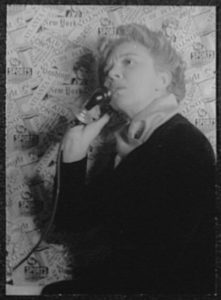 When you think of Surrealism, the images of Salvador Dalí and René Magritte often come to mind. But Leonor Fini seems to be a relatively well-kept secret among collectors. Though she exhibited with the Surrealists in Milan and Paris, she was not always recognized as an artist of the same caliber as the rest. But nowadays, her work is becoming increasingly popular among twenty-first-century collectors. Her paintings look like they are pulled from dreams, myths, and fantasy stories, many featuring strong women as their focal points. Fini rejected traditional notions of femininity both in her art and her lifestyle. In the works of most male Surrealists, women are the objects of desire, while her paintings often depict women as powerful and autonomous, or as she called it, “governed by passion.” She also incorporated animal elements into her works, both from this world and that of myth and fantasy. In her personal life as well, she frequently defied gender norms. One story goes that when she was asked to meet some other Surrealist painters at a Paris café, she came dressed in the red robes of a Roman Catholic cardinal. She claimed that she took great pleasure in wearing the clothes of men forbidden to touch a woman’s body. Fini was both bisexual and polyamorous, saying that she “always preferred to live in a sort of community”.
When you think of Surrealism, the images of Salvador Dalí and René Magritte often come to mind. But Leonor Fini seems to be a relatively well-kept secret among collectors. Though she exhibited with the Surrealists in Milan and Paris, she was not always recognized as an artist of the same caliber as the rest. But nowadays, her work is becoming increasingly popular among twenty-first-century collectors. Her paintings look like they are pulled from dreams, myths, and fantasy stories, many featuring strong women as their focal points. Fini rejected traditional notions of femininity both in her art and her lifestyle. In the works of most male Surrealists, women are the objects of desire, while her paintings often depict women as powerful and autonomous, or as she called it, “governed by passion.” She also incorporated animal elements into her works, both from this world and that of myth and fantasy. In her personal life as well, she frequently defied gender norms. One story goes that when she was asked to meet some other Surrealist painters at a Paris café, she came dressed in the red robes of a Roman Catholic cardinal. She claimed that she took great pleasure in wearing the clothes of men forbidden to touch a woman’s body. Fini was both bisexual and polyamorous, saying that she “always preferred to live in a sort of community”.
As I said before, this list is not a ranking, and it certainly is not all of the great LGBT artists that have ever lived. I would have liked to write about Grant Wood, Diane Arbus, Caravaggio, Jasper Johns, Andy Warhol, John Singer Sargent, and Tamara de Lempicka, but I had to keep myself under control. It's important to highlight these artists not only for their contributions to the arts but serving as examples for queer people in the generations to come.
____________________
Deeper Thoughts
By: Nathan & Howard
British Museum’s Petroleum Partnership At An End
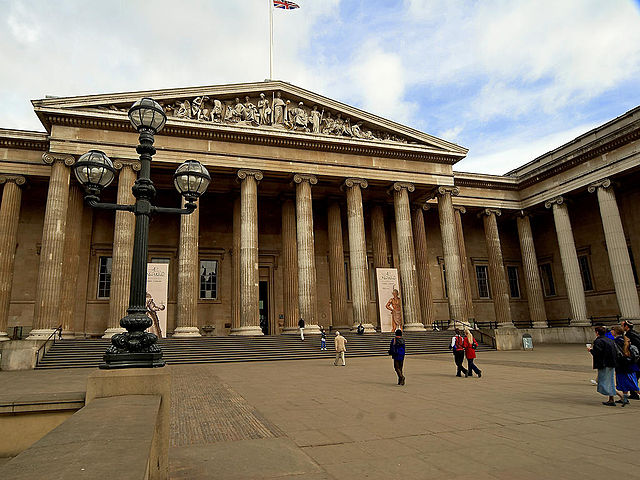 The British Museum is a behemoth so extensive and unwieldy that it is often the last to conform to changes made long ago by comparable museums. They are noticeably behind the curve regarding issues like repatriation and NFTs. However, they finally got on board with one major point activists have been demanding for years. After 27 years of partnership, the British Museum has finally cut ties with British Petroleum.
The British Museum is a behemoth so extensive and unwieldy that it is often the last to conform to changes made long ago by comparable museums. They are noticeably behind the curve regarding issues like repatriation and NFTs. However, they finally got on board with one major point activists have been demanding for years. After 27 years of partnership, the British Museum has finally cut ties with British Petroleum.
BP was a major sponsor of the British Museum via a five-year contract that ended in February, and neither organization has announced any plans of renewing or renegotiating a similar contract. Many have pointed out that while this is promising, it is not definite. One museum source confirmed that “there are no other contracts or agreements in effect between the museum and BP”. Climate activists are still calling for the British Museum or BP to make an official announcement about the partnership’s future. If the British Museum does decide not to continue its relationship with BP, not only will it lose the company’s money, but it will have to remove BP’s name from galleries, theaters, and other spaces it operates. If such an announcement comes, environmental activists will probably lighten up on the British Museum just a little, focusing on some museums that still maintain ties with petroleum companies, like the London Science Museum.
One by one, British arts organizations have been cutting their ties with BP: In 2016, it was the Tate galleries, then the National Galleries of Scotland in 2019. In February 2022, London’s National Portrait Gallery made headlines when it cut ties with BP after nearly 30 years. Most recently, the Royal Opera House in Covent Garden ended its BP sponsorship, leaving the British Museum as the only major British cultural institution to maintain ties with the petroleum giant. The British Museum has taken some steps, however lackluster, to support environmental causes. In December 2022, the museum administration announced its plans to become net carbon zero by refurbishing the original museum building built in the 1830s. The museum administration has previously defended accepting money from BP, saying it was a financial necessity. However, with environmental protesters taking more direct action and posing more of a danger to the museum’s collections, perhaps the board of trustees is shifting their priorities slightly. Ahdaf Soueif is a British-Egyptian novelist who served on the museum’s Board of Trustees until resigning in protest in 2019 over the museum’s continued partnership with oil and gas companies. In light of the British Museum’s latest decision, she said that petroleum companies use cultural institutions “to look like a force for good in society; denying them this platform is important.”
Sotheby’s Buys The Breuer
 945 Madison Avenue, commonly called the Breuer Building, may not be the tallest in Manhattan, but it’s certainly one of the most distinct. Built between 1964 and 1966 based on brutalist designs by Marcel Breuer, the Breuer Building was built to be the home of the Whitney Museum of American Art. In 2014, when the Whitney moved to its now-current location on Gansevoort Street in Manhattan’s Meatpacking District, the Whitney maintained ownership of the building but leased it out to other museums. For example, the Metropolitan Museum of Art leased the Breuer Building between 2016 and 2020, housing the Met’s collection of contemporary art. Starting in 2021, the Frick Museum started its own three-year lease of the building to house its collection while the Frick Mansion, five blocks south, undergoes a $160 million renovation and expansion. But now, the Breuer Building has changed ownership for the first time since its construction. Last week, Sotheby’s purchased the building from the Whitney for $100 million with plans to move their headquarters there. (Photo courtesy of Ajay Suresh)
945 Madison Avenue, commonly called the Breuer Building, may not be the tallest in Manhattan, but it’s certainly one of the most distinct. Built between 1964 and 1966 based on brutalist designs by Marcel Breuer, the Breuer Building was built to be the home of the Whitney Museum of American Art. In 2014, when the Whitney moved to its now-current location on Gansevoort Street in Manhattan’s Meatpacking District, the Whitney maintained ownership of the building but leased it out to other museums. For example, the Metropolitan Museum of Art leased the Breuer Building between 2016 and 2020, housing the Met’s collection of contemporary art. Starting in 2021, the Frick Museum started its own three-year lease of the building to house its collection while the Frick Mansion, five blocks south, undergoes a $160 million renovation and expansion. But now, the Breuer Building has changed ownership for the first time since its construction. Last week, Sotheby’s purchased the building from the Whitney for $100 million with plans to move their headquarters there. (Photo courtesy of Ajay Suresh)
Sotheby’s did not need extra space, as their current flagship location on York Avenue comprises ten stories. But, according to Sotheby’s CEO Charles Stewart, buying the Breuer Building was “a once in a lifetime opportunity that we couldn’t pass up.” Once the Frick completes its renovations and moves out of the Breuer, Sotheby’s will return to Madison Avenue for the first time in thirty-six years. Before moving into its York Avenue location, Sotheby’s was previously located at 980 Madison Avenue, barely more than a block from the Breuer Building. The move to the Breuer will place Sotheby’s in a more central location since the current York Avenue headquarters may seem a little out-of-the-way for some visitors. This will bring Sotheby’s closer to the other major Manhattan museums and galleries, as well as allow more visitors to view the works featured in the upcoming sales free of charge.
Sotheby’s plans to hire architects to redesign the Breuer Building’s interior while maintaining its overall look and structural integrity. Adam Weinberg, director of the Whitney, described the sale as “bittersweet”, but it had to be done since it made little sense to retain ownership of the building. “For us it became clear it did not really make sense to have a divided Whitney”. While the Whitney is centralizing, the Breuer purchase is just the latest move in Sotheby’s recent expansion. On top of the Breuer Building, the auction house purchased a 240,000-square-foot facility in Long Island City, Queens, for art storage last year. Next year, Sotheby’s is also expected to complete the expansions of their Hong Kong and Paris locations.
Ingres: A Painter’s Own Worst Enemy
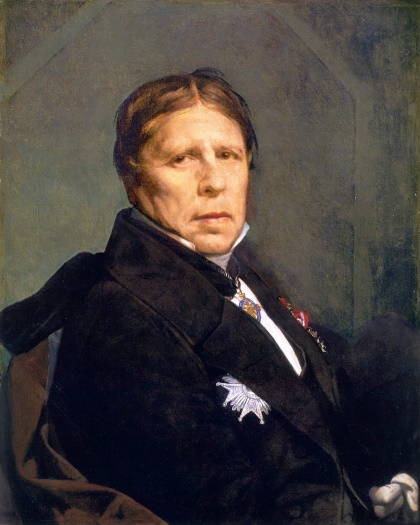 Jean-Auguste-Dominique Ingres was one of France’s great nineteenth-century master painters. He is often regarded as a Neoclassicist, but his work often transcended categories and labels. He was a bastion of artistic conservatism, often opposing the passion and sensuality of the Romantic painters. But Ingres may have been shocked to know that his works inspired not just academic painters but the modernists and avant-garde artists of the late nineteenth and twentieth centuries.
Jean-Auguste-Dominique Ingres was one of France’s great nineteenth-century master painters. He is often regarded as a Neoclassicist, but his work often transcended categories and labels. He was a bastion of artistic conservatism, often opposing the passion and sensuality of the Romantic painters. But Ingres may have been shocked to know that his works inspired not just academic painters but the modernists and avant-garde artists of the late nineteenth and twentieth centuries.
After studying under Jacques-Louis David and working as a portraitist in French-controlled Rome, Ingres soon became one of the leading figures in the divide between Neoclassical and Romantic painters. In a real-life personification of this divide, he developed a rivalry with his contemporary Eugène Delacroix. Delacroix’s work is sensual and colorful, while Ingres produced more refined and clean work, keeping within the academic tradition. Some art historians argue that the Neoclassical-Romantic divide continued an artistic divide from over a hundred years earlier. In 1671, an argument broke out among members of the Royal Academy as to what artistic component was the most important in a work: form or color. The Academy divided itself into factions, with the Poussinistes, named after the French Baroque painter Nicolas Poussin, arguing that the form of the subject deserved the most attention (and that color was merely decorative). Meanwhile, the Rubenistes, named after the Flemish master Peter Paul Rubens, prioritized color. They argued that color was paramount because the point of art was to strive towards recreating nature itself. At the same time, the Poussinistes believed that the point of art was to take a subject in one’s mind and recreate its form using nature as a mere reference point. The supposed “resolution” to this argument occurred decades later when the Academy admitted Rococo painters like Antoine Watteau. Despite the matter’s resolution in the early eighteenth century, these same arguments continued into the nineteenth through Ingres and Delacroix. Delacroix once described Ingres’s work as “the complete expression of an incomplete intelligence”. Meanwhile, some report that whenever Delacroix would enter a room, Ingres would mutter, “I smell brimstone.” There are stories that involve the two artists nearly coming to blows and having to be separated. However, similar to the stories about the strained relationships between van Gogh and Gauguin or between Degas and Manet, some of the more sensational stories may contain some exaggeration.
Despite being rooted firmly in traditional artistic styles, Ingres found a way to incorporate abstraction into his academic works so that the subjects could achieve the form he desired. His depiction of the human form often went beyond the classical ideal. His paintings like Jupiter and Thetis and Roger Freeing Angelica show contortion that does not quite fit within the sculpted confines of the Greco-Roman aesthetic. Even in his portraits, Ingres did not always stick to strict realism. For example, his 1856 Portrait of Madame Moitessier may seem inoffensive until you look at the subject’s hands. They seem unnaturally shaped, as if they’re made of rubber, fingers bending this way and that. In this abstraction, Ingres unwittingly exerted a massive amount of influence on later modernists, who would develop styles completely contrary to the academic orthodoxy Ingres stood for. The Impressionists, for example, drew an incredible amount of influence from Ingres’s use of form. They also admired one rather paradoxical aspect of his career: despite being a defender of the academic style, Ingres did not hold the Academy’s Salon in the highest regard. Though he had little respect for the nonconformist Romantics, he still recognized that the academic establishment offered little room for experimentation and artistic independence. These same grievances led a new generation of artists like Manet, Monet, Pissarro, Degas, and Renoir to break from the Academy, form independent salons, and develop their own styles.
Even into the twentieth century, Ingres, the pillar of academic conservatism, influenced abstract painters. The aforementioned Portrait of Madame Moitessier must have made quite the impression when Pablo Picasso first saw it at the Louvre since he decided to use it as a model for his own 1932 portrait Woman with a Book. Some art historians also claim that Ingres’s portrait of Louis-François Bertin partly inspired Picasso’s renowned Gertrude Stein portrait. Furthermore, Ingres’s 1859 Turkish Bath likely influenced the form of Picasso’s Les Demoiselles d’Avignon. This list goes on and on. But there is a touch of irony to Ingres’s legacy. He was one of France’s great nineteenth-century artists. He idolized Jacques-Louis David and the neoclassical style, becoming a pillar of academic painting at a time when Romantic and later modernist styles were taking over. And yet, the very things that set him apart from some other academics were what inspired the impressionists, the cubists, the surrealists, and the other modernists who experimented and pushed art to its limits in the century-and-a-half following his death. Nevermind Delacroix; it was Ingres himself who, through his work, became his own worst enemy.
Go For The Gold: When The Olympics Awarded Art Medals
 Next year, Paris will host the Summer Olympics. The location is fitting given that Paris was also the host city for the Olympics one century earlier, hosting the 1924 games. A hundred years apart, these two games will probably look very different, even if you look at the events. For example, the 1924 games did not include volleyball, archery, triathlon, badminton, or rhythmic gymnastics. Meanwhile, the upcoming Paris games will not be featuring polo. But the 2024 Olympics will also be missing something that for decades was just as much a part of the Olympics as diving, wrestling, and weightlifting: painting.
Next year, Paris will host the Summer Olympics. The location is fitting given that Paris was also the host city for the Olympics one century earlier, hosting the 1924 games. A hundred years apart, these two games will probably look very different, even if you look at the events. For example, the 1924 games did not include volleyball, archery, triathlon, badminton, or rhythmic gymnastics. Meanwhile, the upcoming Paris games will not be featuring polo. But the 2024 Olympics will also be missing something that for decades was just as much a part of the Olympics as diving, wrestling, and weightlifting: painting.
Between 1912 and 1948, the Olympic Games held competitions and awarded medals for art. Artists worldwide could compete for medals in architecture, music, painting, sculpture, literature, and other categories. Baron Pierre de Coubertin, the founder of the modern Olympics, tried to include art competitions from the very beginning. He stated that in the ancient games, “sport exhibitions walked in equality with artistic exhibitions,” which sets the Olympics apart from other sporting events. The one rule was that the works’ subjects had to be related to sports and athletics. Architects submitted plans for arenas and stadiums, composers wrote marches of victory for the medalists, and sculptors created works reminiscent of Myron’s ancient athletic statues.
The art competitions were somewhat controversial. Many artists at the time simply ignored or flat-out refused to submit their work to the Olympic juries, primarily because they disliked viewing art as a competition. Similar to some of the grievances French modernists had regarding the academic Salon, some believed that the Olympic judges could be viewed as the new tastemakers. This was particularly upsetting for them since most of the judges lacked an artistic background. However, many artists were happy to submit their work. One of the most prolific artists who participated in the Olympics multiple times was the British sporting artist Alfred Munnings. Though he never won any medals, Munnings submitted paintings for the 1928 Amsterdam Games, the 1932 Los Angeles Games, and the 1948 London Games. Participating artists at the Amsterdam games also included Childe Hassam and George Grosz. At the Los Angeles games, great American artists like George Bellows, Thomas Eakins, and Winslow Homer had work on display. However, these artists had died 7, 16, and 22 years before, respectively; their works exhibited hors concours, meaning they were not submitted for the competition.
The International Olympic Committee decided not to continue the art competitions for the 1952 games in Helsinki, but not for the reason you would expect. Of course, nowadays, we might hear of the Olympic art competitions and think Oh, how silly they were, everyone knows art isn’t a sport. But the art competitions were discontinued because of a rule that has been done away with: the Olympics were meant for competitions among amateurs. They determined that many of these artists were professionals, so it would be improper for them to compete. One fascinating example of this is Alfréd Hajós, an example of the kind of amateurism the Olympics originally encouraged. Hajós won gold medals in swimming at the first modern Olympics held in Athens in 1896. But, of course, he was not a professional swimmer; rather he was an architect. He became one of only two Olympians to win medals in both sports and art when he won a silver medal for his designs for a stadium at the 1924 Paris Games.
After the end of the art competitions, the one hundred fifty-one medals awarded for the arts during the Olympics were stricken from the record, and they no longer count towards their countries’ totals. But even if only a small handful of artists were ever recognized with medals, that does not mean they go completely unrecognized today. The last recipient of an Olympic gold medal for painting was the British artist Alfred Thomson. He had previously worked as a commercial artist, designing posters and advertisements. Then, when war broke out in 1939, he worked as a war artist with the Royal Air Force. He won the gold at the 1948 London Olympics with The London Amateur Boxing Championship. Over six decades later, the painting sold at Christie’s London for £60K hammer, or 7.5 times the £8K high estimate. That painting is still Thomson’s auction record. Though they may not be giving out medals for paintings anymore, the arts remain and fundamental component of the Olympics.
National Portrait Gallery Reopens
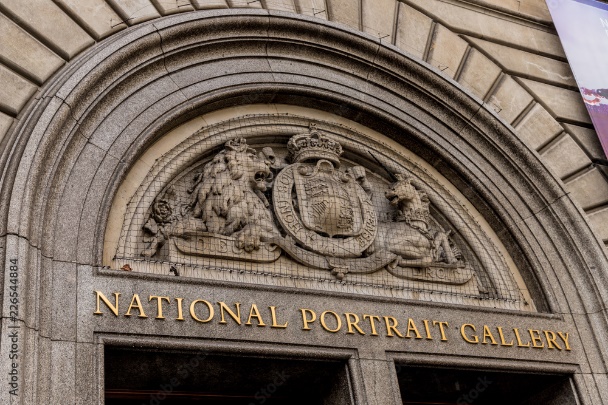 Trafalgar Square is one of London’s most iconic public spaces. Apart from Nelson’s Column and the enormous bronze lion statues, the square is also the site of some of London’s great cultural institutions, including the National Gallery and the recently-reopened National Portrait Gallery. The NPG opened its doors back up earlier in the week after nearly three years of renovations. The museum is home to some of Britain’s finest examples of portraiture across all media, including the famous Chandos Portrait of William Shakespeare, Yousuf Karsh’s photograph of Winston Churchill, and Allan Ramsay’s resplendent portraits of King George III and Queen Charlotte.
Trafalgar Square is one of London’s most iconic public spaces. Apart from Nelson’s Column and the enormous bronze lion statues, the square is also the site of some of London’s great cultural institutions, including the National Gallery and the recently-reopened National Portrait Gallery. The NPG opened its doors back up earlier in the week after nearly three years of renovations. The museum is home to some of Britain’s finest examples of portraiture across all media, including the famous Chandos Portrait of William Shakespeare, Yousuf Karsh’s photograph of Winston Churchill, and Allan Ramsay’s resplendent portraits of King George III and Queen Charlotte.
One of the most notable changes to the gallery is the entrance. Right after passing through Trafalgar Square, the NPG now offers a small forecourt and three enormous bronze doors created by Tracey Emin. The doors are decorated with forty-five panels, each with a different female face. This was rather intentional, installed as an echo or response to the eighteen carved relief busts of great men of the arts like Sir Joshua Reynolds, Hans Holbein the Younger, and Anthony van Dyck. Gallery visitors can see these busts looking down on them from high up on the building’s exterior. Emin stated that she did not want the faces on the doors to be specific, identifiable women, but a collage meant to represent all womanhood: “I felt like the doors of the National Portrait Gallery should represent every woman, every age and every culture throughout time.” In the same sense, the curators’ rehang for the opening also tries to reflect a more balanced approach. In the past, many have commented on the gender imbalance among the artists represented on the gallery walls. When the NPG closed for renovations, about 35% of the artists represented were women. Now, 48% of the portraits on display are by female artists.
Despite this marked improvement, many critics wrote that the rehang seems slightly underwhelming. Much emphasis is given to Tudor and Victorian portraits, while the twentieth- and twenty-first-century works seem a little difficult to locate. Writing for The Guardian, Jonathan Jones described the NPG, both before and after the renovations, as “a museum with barely any great art in it”. Jones also wrote that despite the curators’ best attempts, the NPG is still “a collection of notable faces with no regard for artistic depth.”
Sir Paul McCartney was present at the reopening since one of the Gallery’s inaugural exhibitions will be a series of the musician’s photographs. Eyes of the Storm will include some rare photographs McCartney took with his 35mm camera between 1963 and 1964, showing scenes from the Beatles’ touring days across Europe and North America. Also present was Catherine, Princess of Wales, as she is the gallery’s royal patron. But there was some gossip about the princess and the new rehang in the weeks leading up to the reopening. Some noticed that one particular work was missing, a portrait of Prince William and Prince Harry by the painter Nicky Phillips. The painting was created around 2010, showing a candid moment between the two brothers dressed in military uniforms. Because of the princess’s royal patronage and the scandalous rift between the two princes that has widened in recent years, some speculate that Catherine pulled some strings to remove the princely double portrait from the new rehang. The NPG has denied these accusations, pointing out that the Phillips portrait has not been on display since 2018, about two years before the gallery closed for renovations. Of course, logically, the princess probably doesn’t have much influence over the gallery curators. It also seems more like a plot point from a television drama than real life. But yet again, that won’t exactly stop people from speculating.
A Kingly Collection Gets A Home

The Spanish Royal Collection is one of the greatest private art collections in the world. The Habsburg and Bourbon families amassed an incredible collection and served as patrons for several great European artists, including Diego Velázquez, Francisco de Goya, Titian, and Hieronymus Bosch. And now, close to a century after it was first suggested, the Royal Collection will be getting a museum of its own, open to the public.
The government started toying with the idea of a public museum to house the Spanish Royal Collection in the 1930s during the Second Republic. These plans got derailed, however, when Francisco Franco and his nationalist generals revolted against the Republic and started the Spanish Civil War. The Patrimonio Nacional, Spain’s national heritage agency that oversees Crown property, revived the idea in 1998, and the museum's construction began in 2006. The project faced delays for various reasons, including budgetary issues and finding archaeological remains at the building site. Though construction was completed in 2016, finishing the interior was further complicated due to costs. But finally, after decades and €172 million, the Royal Collections Gallery opened on Wednesday, June 28th. Patrimonio Nacional’s president Ana de la Cueva described it as “the biggest museum project in Spain in decades, and also in Europe.”
The structure itself is certainly imposing, reminiscent of an enormous, colonnaded Greco-Roman palace. The design seems fitting, given it’s only a stone's throw away from the actual Royal Palace. The new museum will feature the collection of the Habsburg kings (who ruled Spain between 1516 and 1700), while another section of galleries will contain selections from the collection of the Bourbon family (which took over after the Habsburgs and currently sits on the throne today). The building also has several floors of underground galleries, some of which will be entirely dedicated to temporary exhibitions, the royal carriages, and the collection’s many tapestries. The royal collection contains about 170,000 items, including paintings, sculptures, tapestries, jewelry, drawings, and other pieces. If it wanted, the museum could circulate its works on display and replace them with new ones every day for over eight months without any repeats. So it’s safe to say that the new museum administration will have no problem keeping the galleries populated with new works, many of them never publicly exhibited before. Furthermore, the Patrimonio Nacional oversees nineteen royal properties with plenty of wall space, so the government might not have to spend too much on storage.
The collection’s highlights include Velázquez’s White Horse, Salome with the Head of Saint John the Baptist by Caravaggio, and a first edition of Don Quixote by Miguel de Cervantes. There are also more recent additions to the collection, like Antonio López García’s group portrait Family of Juan Carlos I, featuring the titular former king and his son, the current king Felipe VI who will be present at the museum’s inauguration. Who knows? With the museum’s opening, let’s hope this makes the Prado slightly less crowded.
Pope Francis Addresses The Art World
Last Friday, Pope Francis opened the doors of the Sistine Chapel to address an assembly of two hundred prominent artists. This occasion marked the fiftieth anniversary of the Vatican Museum’s modern and contemporary collection, and it mirrors a similar event from decades ago.
The 1960s and 1970s were a time of great change for many. This was especially true for the Catholic Church, which experienced more institutional change than it had in several centuries. The Second Vatican Council, called by Pope John XXIII in 1962, sought to bring the Church into the modern world. It resulted in priests being able to perform mass in the vernacular language rather than Latin, the expansion of laypeople’s role within the Church, and the opening of doors to interreligious dialogue. One of the ways that the Church opened itself up to the wider world was through the arts, particularly modern and contemporary art that it had often previously denounced. Fifty years ago, in 1973, Pope Paul VI opened the modern and contemporary collection of the Vatican Museums.
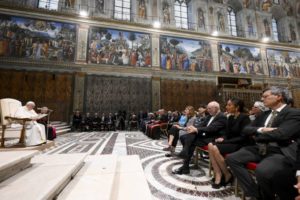 Paul VI had previously reached out to modern art earlier in his papacy, inviting artists to the Vatican. He assembled them in the Sistine Chapel and spoke of the significance of art and artists to the Church, much like his successor Francis last Friday. He also spoke of his desire to bridge the gap that had formed between the Church and the arts in recent years. The original thousand-piece collection of the Vatican Museum’s modern and contemporary section included works by Vincent van Gogh, Francis Bacon, Marc Chagall, and Henri Matisse. It has since swelled to an impressive 9,000-piece collection featuring religious art of all sorts.
Paul VI had previously reached out to modern art earlier in his papacy, inviting artists to the Vatican. He assembled them in the Sistine Chapel and spoke of the significance of art and artists to the Church, much like his successor Francis last Friday. He also spoke of his desire to bridge the gap that had formed between the Church and the arts in recent years. The original thousand-piece collection of the Vatican Museum’s modern and contemporary section included works by Vincent van Gogh, Francis Bacon, Marc Chagall, and Henri Matisse. It has since swelled to an impressive 9,000-piece collection featuring religious art of all sorts.
But some artists were present on Friday that many may not have expected. The name that everyone seems to mention is Andres Serrano, the American photographer known for being the target of conservative culture warriors since the 1980s. Serrano gained public notoriety in 1987 when he debuted his photograph Piss Christ, featuring a crucifix submerged in a glass of his own urine. Many denounced the work as blasphemous, drawing the ire of senators Alfonse D’Amato and Jesse Helms after learning the work won an award partially sponsored by the National Endowment for the Arts. Serrano claims he never meant it as blasphemy and is a lifelong Catholic. At the event on Friday, Serrano said, “I was surprised to be invited and even more surprised that [the Pope] gave me a thumbs up”.
Also present for Pope Francis’s address were sculptor Anish Kapoor, painter Anselm Kiefer, and Abel Ferrara, director of the 2022 film Padre Pio. Francis told the crowd, “Like the biblical prophets, you confront things that at times are uncomfortable; you criticize today’s false myths and new idols, its empty talk, the ploys of consumerism, the schemes of power.”
The Rehs Family
© Rehs Galleries, Inc., New York – July 2023
